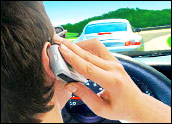
The dangers associated with cell phones could far outweigh those tied to asbestos and smoking, an Australian doctor recently warned in a new report.
In his paper, “Mobile Phones and Brain Tumors — A Public Health Concern,” Vini G. Khurana, a staff specialist neurosurgeon at the Canberra Hospital and associate professor of neurosurgery with Australian National University Medical School, summarizes a 14-month study in which he reviewed previous reports on the effects of mobile phone usage in medical and scientific publications as well as the popular press.
“There is a significant and increasing body of evidence for a link between mobile phone usage and certain brain tumors,” Khurana writes. “The link between mobile phones and brain tumors should no longer be regarded as a myth.”
Fourfold Risk Possible
Cell phones can be invaluable in emergency situations and have contributed to the quality of human life, Khurana acknowledges. However, when used heavily over many years, the electromagnetic radiation they produce can do harm to the brain, which is itself an electrical organ, he notes.
Cell phones can also heat up the contents of the head, he notes.
There is strong evidence suggesting a relationship between the length of cell-phone usage and the delayed occurrence of an acoustic neuroma or astrocytoma brain tumor on the same side of the head as the “preferred side” for phone usage, Khurana adds, amounting to a risk increase of 200 percent to 400 percent.
“Given the widespread use of mobile phones by children and adults alike, the presence of any health risk posed by long-term near-field radiation will inevitably set the stage for the emergence of a global public health problem,” Khurana writes.
Back to Landlines?
The scientific and medical communities need to reevaluate previous studies that found no link between cell phones and brain cancer, Khurana says, and the telecommunications industry needs to expedite the development and promotion of “safe, practical and ubiquitous EMR/radiofrequency shielding devices for mobile and cordless phones and their Bluetooth and headset accessories.”
It also should further refine hands-free speakerphone options, he says.
Consumers, meanwhile, should use landlines whenever possible, he said, or at least speakerphone options when available. They should minimize the use of mobile and cordless phones in general as well as Bluetooth devices and unshielded headphone accessories, he says.
Children, Khurana added, should use wireless technologies only in emergency situations.
‘One Person’s Opinion’
The cellular industry is yet to be convinced.
“This is just one person’s opinion of existing research,” Joe Ferren, a spokesperson for CTIA-The Wireless Association, told TechNewsWorld.
The link between mobile-phone use and cancer is even listed among the American Cancer Society’s “Top 10 Cancer Myths,” Ferren noted.
“There is a consensus among global health organizations and leading scientists that there is no association between wireless usage and health effects,” Ferren said.
The Next Tobacco Industry?
Given the widespread nature of cell phones and the divergent results of the many studies that have been done, it will be difficult for consumers to draw any clear-cut conclusions.
“Could this cause people to overreact? I see that being inevitable,” David Chamberlain, principal analyst with In-Stat, told TechNewsWorld. “Someone will want to pass a law somewhere.”
It’s to be expected that the wireless industry would downplay any such fears, Chamberlain added, noting that one day, “they could look like the tobacco companies.”
‘Life’s a Risk’
In the meantime, however, “I think everybody should just continue to make their own choices just the way we do when we decide to wear helmets when we ride motorcycles or to wear kneepads when we skateboard,” Chamberlain said. “It’s all about the same thing.”
For now, “I don’t know what can be done, other than individuals taking steps to ensure their own safety when they perceive a risk,” Chamberlain concluded. “Life’s a risk, and making our own choices is all we can do.”





















































